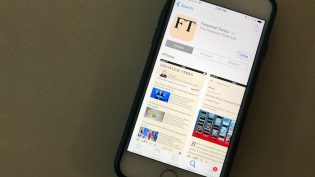The internet tells me that you can choose to play Fortnite — “The Most Important Video Game on the Planet” — solo, with a partner, or as part of a squad. The game’s publisher, Epic, may look like it’s taking on the tech giants solo — but it’s really fighting on behalf of a squad that also includes news publishers.
In case you haven’t heard: Last week, Epic tried to get around Apple’s in-app purchasing system — in which Apple takes a 30 percent cut of sales — by adding its own purchasing system to Fortnite on iOS. That’s against Apple’s rules for the App Store — so Apple kicked Fortnite out. Epic, having gotten the response it expected, immediately sued Apple (and Google, which had followed the same playbook on Android), saying that the two giants’ app store policies are unfair monopolies when it comes to software distribution on mobile devices.
Which…isn’t a bad argument.
The past couple of years have been filled with complaints about the aggregated power of Google, Apple, and a few other tech titans. For app stores, though, the imbalance of power has been too big to prompt any real change. Apple took a 30 percent cut of App Store purchases when it launched in 2008; it still does today.
But it’s one thing for small developers to complain; it’s another for Netflix, Epic, Spotify, or Sonos — much less Amazon or Facebook — to raise a fuss, legal or otherwise. Apple cut a special deal to quiet its most potent opponent on that list, Amazon. Epic, though, seems prepared to push this to some sort of legal conclusion.
Publishers — news publishers, I mean, not just game publishers — should be paying close attention, because Apple’s tax on digital content impacts them in profound ways. News publishers only rarely charge directly for their apps — a one-time fee for an ongoing news operation doesn’t make much sense — but they do offer lots of subscriptions, which the demise of advertising has rendered ever more central to publishers’ business models. And if someone subscribes to a newspaper or magazine through Apple’s system, the publisher has to lop 30 percent right off the top of its revenue.
Different outlets have responded to Apple’s setup (which Google roughly mirrors) in various ways. The Financial Times famously pulled its mobile app from the App Store in 2011 over both data and rev-share concerns. (It returned in 2017.)Some raise their subscription rates 30 percent to both (a) cover Apple’s cut and (b) hopefully push some would-be subscribers back to a direct subscription. (Though Apple’s rules don’t even let you tell the user they can get a better deal over at your dot-com.)
And some — most, from what I can tell — simply eat the difference. Want to subscribe to The New York Times on your iPhone? If you’re looking at NYTimes.com in your browser, you might get one of any number of offers the Times is testing and thinks might work for you. (In a logged-out window, I just got offered $1/week for the first year, then the full $4.25/week standard rate after that.) But if you’re in the Times’ iOS app, you get a rigid offer for $16.99 a month.
So on the website, the Times will get $52 for a new subscriber’s first year, then $221/year every year thereafter. On the App Store, the Times will get $142 for a subscriber’s first year, accounting for Apple’s cut, even though it would like to charge less to hook in new subscribers. And ever year thereafter, the Times gets $173 — $48 less than it would like. (Apple reduces its cut from 30 percent to 15 percent after the first year of a subscription.)
Apple’s rigid policies also make it harder to test different kinds of subscription offers — a free one-month trial versus 99¢/week for the first three months versus a discount rate for the first year, and so on. Propensity-driven paywalls are a real source of growth in digital subs for publishers, and they’re just about impossible to pull off in the App Store.The explosion of SaaS companies has meant there are a ton of companies selling subscriptions on the App Store. But the vast majority of them were born in the iPhone era and have set up a cost structure attuned to the distribution costs they expect. But most subscription publishers existed long before the iPhone and have large fixed costs — like a newsroom that produces new content everyday — and a subscriber base that is still mostly not using app store purchasing. All that means the pricing crunch can be even more severe for them.
It’s even more galling knowing that Apple only applies its restrictions to digital content — a print subscription doesn’t face the same cut — and that Apple has a separate payment system, Apple Pay, that takes a traditional, credit-card-processor-sized cut. (So if I pay my neighborhood sushi place to bring me dinner, Apple only charges 0.15 percent through Apple Pay. But if I subscribe to SushiNewsToday.com on my iPhone, Apple gets 30 percent?)
How is this all going end? Who knows — Epic seems determined, and you get the sense this could be the moment in which a decade of frustration finally turns into action, either by the tech giants voluntarily or by regulators, Congress, or the courts. An easy, secure one-tap subscription was a huge deal a decade ago, when screens were tiny and people were nervous about entering credit card numbers. But today, any number of tools and vendors have made buying an online sub pretty darn straightforward.
I see three potential outcomes. One, Apple and Google stand their ground and Epic can’t convince a judge that it’s an antitrust violation.
Two, Apple and Google agree to cut their shares under some set of cases, as Apple did in 2016 when it dropped to 15 percent after the first year of a subscription. Maybe it exempts certain categories. (I hear robust news organizations are important to democracy.) Maybe the cut drops to zero after a certain length of time. Or maybe they just try to reduce their share to, say, 20 percent and hope that quiets the crowd.
Three — the one I consider the most likely — is that a court or regulator eventually agrees with Epic that Apple and Google’s functional monopolies on mobile software distribution are a constraint on trade and a violation of antitrust law. (That court or regulator could be in the United States; it would more likely be in the EU.) The likely outcome would be a ruling that Apple and Google have to allow alternate in-app payment systems on their devices — the way Microsoft was ordered to allow other default web browsers or AT&T was forced to allow other long-distance companies access to the phone network it built.
But I suspect that would still be years away, and you haven’t made too much money betting against the tech giants in recent years. These monopolies generate huge revenues — about $29 billion over the past year — and neither Google nor Apple is likely to give them up lightly. After all, just this morning, Apple became the first company in the history of the world to be worth $2 trillion — only two years after it became the first to hit $1 trillion.
"impact" - Google News
August 20, 2020 at 12:03AM
https://ift.tt/2FFEDTh
Fortnite's battle with Apple and Google could have an impact on news publishers, too - Nieman Journalism Lab at Harvard
"impact" - Google News
https://ift.tt/2RIFll8
https://ift.tt/3fk35XJ
Bagikan Berita Ini


















0 Response to "Fortnite's battle with Apple and Google could have an impact on news publishers, too - Nieman Journalism Lab at Harvard"
Post a Comment